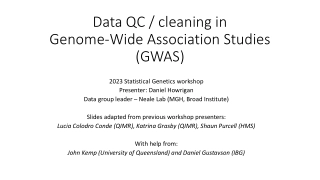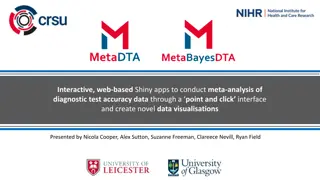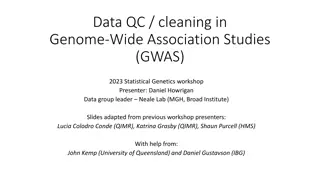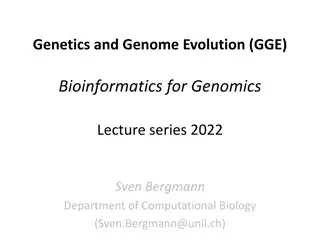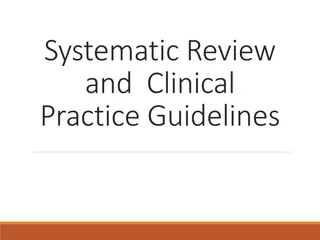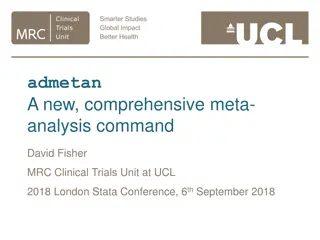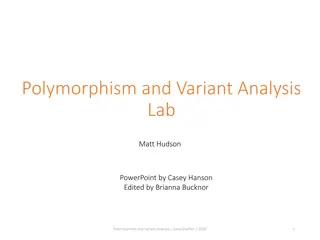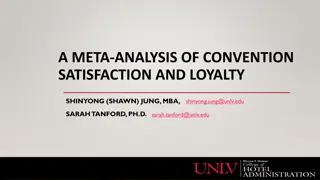Meta-Analysis in GWAS: Methods and Applications
Meta-analysis in GWAS involves combining data across studies to estimate overall effects, explore cohort differences, improve power, and replicate findings. It includes joint vs. meta-analysis, methods, and types such as fixed effect and random effect meta-analyses.
Download Presentation

Please find below an Image/Link to download the presentation.
The content on the website is provided AS IS for your information and personal use only. It may not be sold, licensed, or shared on other websites without obtaining consent from the author.If you encounter any issues during the download, it is possible that the publisher has removed the file from their server.
You are allowed to download the files provided on this website for personal or commercial use, subject to the condition that they are used lawfully. All files are the property of their respective owners.
The content on the website is provided AS IS for your information and personal use only. It may not be sold, licensed, or shared on other websites without obtaining consent from the author.
E N D
Presentation Transcript
GWAS Meta-Analysis Sarah Medland The 2021 Virtual Workshop on Statistical Genetic Methods for Human Complex Traits
Combining data across studies Aims: Estimate the overall, or combined effect Explore differences between cohorts heterogeneity Improve power Replicate effects
Joint vs Meta-analysis Joint analysis Meta-analysis Study 1 Study 2 Study n Study 1 Study 2 Study n E , S E , , S E , , S value , 1 1 2 2 n n All Data P value P value P 1 2 n meta , S E P , value , S E P , value meta meta joint joint joint For common variants, joint and meta-analysis have similar power (Lin & Zeng, Genet. Epidemiol., 2010)
How we use meta-analysis in GWAS Commissioned analyses rather than MA of previously published findings Analysis protocol Imputation reference Phenotypic definition Covariates to be included Population stratification Analyses to be run Output format Study 1 Study 2 Study n E , S E , , S E , , S value , 1 1 2 2 n n P value P value P 1 2 n meta , S E P , value meta meta
Types of meta-analysis Fixed Effect Each SNP has a true effect size on the trait. This effect is shared by all cohorts. The observed effect sizes in the different cohorts will be distributed around the true effect size with a variance that depends on the precision of the different cohorts
Types of meta-analysis Fixed Effect We weight each cohorts effect size by it s precision Error in our estimate is due to random error within studies The combined effect = the meta-analytic estimate
Types of meta-analysis Random Effect The true effect for a SNP varies between cohorts. The studies included in the meta-analysis are assumed to be a random sample reflecting the distribution of true effects
Types of meta-analysis Random Effect Error in our estimate is due to random error within AND between studies Weights reflect these two sources of error and are less dependent on sample size The mean effect in this distribution = the meta-analytic estimate
Types of meta-analysis Random Effect Traditionally, null hypothesis for RE model is that the mean of the effects is 0 lower power than FE Correct null hypothesis for GWAS is that all effects are 0 Modification proposed by Han & Eskin 2011 tests the null hypothesis of exactly 0 effect in every study RE2 Implemented in Meta (webpage no longer works)
Types of meta-analysis Others Bayesian partition model Cohorts are grouped into clusters. Effect is assumed be the same within but different between clusters. MANTRA (Meta-ANalysis of Transethnic Association studies) - Andrew Morris - Genet Epidemiol. 2011; 35(8): 809 822. PMCID: PMC3460225
Types of meta-analysis Others Multivariate GWAS packages MTAG and GenomicSEM next week Continuous & Binary meta-analysis Demontis, Walters et al Nat Genet. 2019; 51(1): 63 75. PMCID: PMC6481311 (Sup information)
Setting up a meta-analysis Start with an analysis plan Decide on QC of input and analytic approach Define your primary analyses Define any secondary analyses sensitivity, populations Map out intended follow-ups Define replication Preregistration or public posting is strongly encouraged Allow a lot more time than you think you will need
Software for running meta-analysis Important considerations Types of analyses the program can run QC requirements Strand flipping Allele frequency tracking What you want to do your output Genomic control vs LDscore regression Beta & SE vs Z
Software for running meta-analysis Software METAL ? GWAMA (Magi & Morris) ? Meta(Han & Eskin) R & Stata packages
QC of cohort level data Variant naming Allele Frequency - MAF .5 or 1% Imputation accuracy (r2) - Typically .6 (.8 if hard calls were analysed) Plots - Manhattan, QQ, P-Z MAF compared to reference - Strand Lambda calculation - Checking for confounding Packages are available to help with this i.e. EasyQC
Choosing an analytic approach Metal Fixed effect analysis Inverse variance weighted Requires: beta, SE, alleles Outputs: beta, SE, p, N, heterogeneity, MAF
Choosing an analytic approach Metal Fixed effect analysis Sample size weighted Requires: direction, P, N , alleles Outputs: Z, p, N, heterogeneity, MAF Sample overlap correction
Choosing an analytic approach Random Metal Requires: beta, SE, p, N, alleles Outputs: Both FE and RE results beta, SE, p, heterogeneity, tau2
Why would you chose N weighted or RE? Inverse variance FE meta-analysis are sensitive to deviations in scaling between studies N weighted FE meta-analyses are less sensitive to this RE meta-analyses are more appropriate for situations where the effect size differs between cohorts
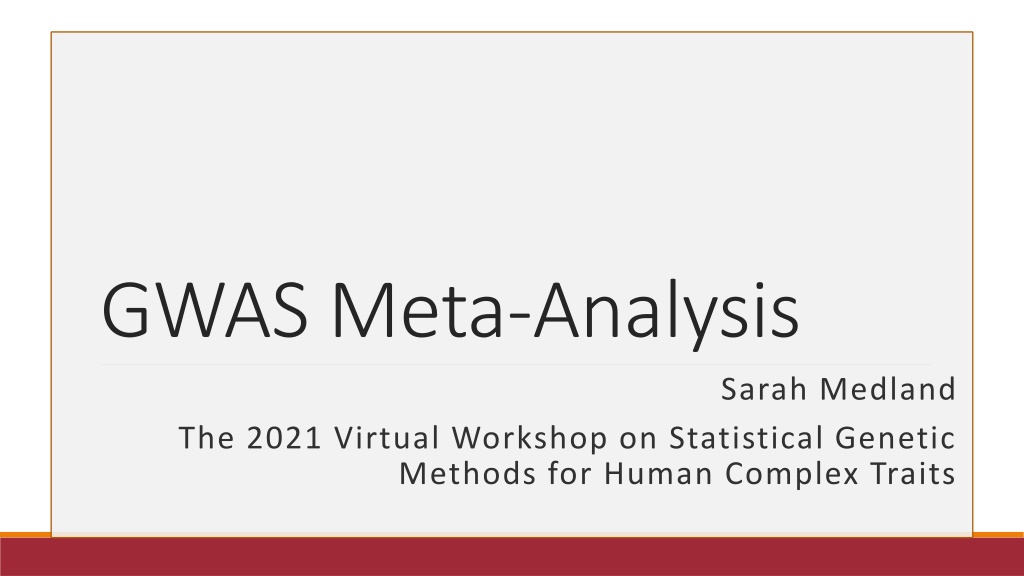
 undefined
undefined










